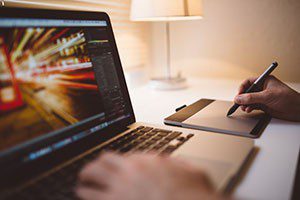6 Easy Copy Writing Tips for Coaches
Are you intimidated by the idea of writing your own freebies, marketing emails, and web content?
I used to find those daunting too until I learned the root of ace marketing copy: write to intrigue rather than impress.
When you want to inspire potential coaching clients to take the next step with you, aim to build a relationship and raise curiosity first. Take the spotlight off of you and your coaching “technology” and place it on your target audience.
Here are six more tried and true copy writing tips that will help you write in a way that’s both authentic and effective:
#1 Write like you speak
Good copy speaks to the heart first so it’s critical to know who you serve, what they want and what’s holding them back. For most target audiences, you’ll want to ditch the formal writing techniques you learned in school. Instead, write as if you’re speaking to one person in your target group.
- Use contractions. You’ll and you’re instead of you will and you are.
- De-formalize your language. Let go of the one whom‘s and in order to‘s.
- And, even risk using an occasional and strategically placed incomplete sentence!
#2 Relate to your target audience
Begin by helping your reader to feel understood. People feel an instant affinity with you if they see that you “get” where they’ve been and where they want to go.
- Use language that honors their intelligence.
- Speak to their SPECIFIC challenges and goals. Broad and general language loses relevance.
- Opt for you and I, instead of we, our or one.
#3 Establish your authority too
While relating to their pain and aspirations, also make it clear that you have a solution to one acute pain they want help with right now. Help them understand why they should listen to you.
- Use imperative phrasing whenever possible. For example, eliminate — I think, I believe, you may, can, could — from sentences and rephrase to more commanding statements (Notice that all the bullet points in this article are imperative and begin with an active verb.)
- Use active voice rather than passive voice whenever possible. Look for ways to replace “to be” verbs — was, were, has been, will be, may be — with stronger verbs.
- Weave in examples of you or your client’s results utilizing your solution.
#4 Give readers a break
People will usually skim a page and read the parts that intrigue them. Pull them through your copy and encourage deeper reading with these devices:
- Use sub-headings. Be sure the syntax is parallel. (Notice how all my subheadings start with a verb?)
- Use bullet points or numbered lists.
- Occasionally bold a short sentence or phrase for emphasis. (Be careful not to over-do it or copy becomes unreadable!)
- With longer documents or web pages, include a few images or boxed information such as quotes, pull quotes, and factoids.
#5 Streamline every sentence and paragraph
Most of the time, less really is more! Long, dense paragraphs scare readers away. This is where academic training, that insists all relevant content goes into one paragraph, can lead you astray. After you write a first draft, challenge yourself to reduce the number of words by half. Play around with syntax to finesse each sentence.
- Read your copy out loud to highlight awkward passages.
- Eliminate non-essential words and phrases.
- Reduce the number of prepositional phrases.
- Trim paragraphs to 5 lines of text wherever possible. (Notice the short paragraphs in this article?)
One exception to the “less is more” rule is the dreaded sales page. Those pages are purposefully long so that each individual finds the specific information that helps them decide whether to buy or not. Some people will look for testimonials right away where others want to know exactly what they’ll get in a program first. Others want the story in the initial sales letter, while others will look for the guarantee. It’s best to get expert support for writing those.
#6 Inspire readers to take action
If you want comments on your blog article, ask for them and provide an easy way to give them. If you want web visitors to sign up for your freebie, make the title irresistible and place the opt-in high up on the web page. If you want people to enroll for a paid program build a case for why they can’t afford NOT to enroll.
Author: Rhonda Hess co-authored the Coach Training AcceleratorTM and designed the CTA Certified Coach Program. She has a super power for helping coaches choose and champion a profitable niche they’ll love. Learn more at Prosperous Coach.


 Print
Print









